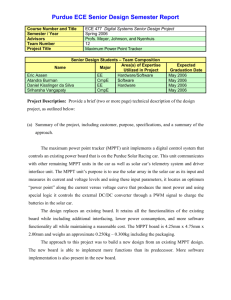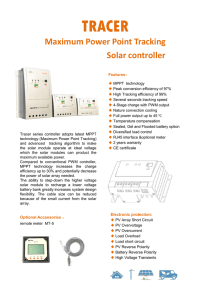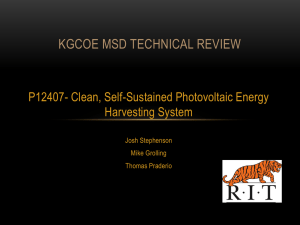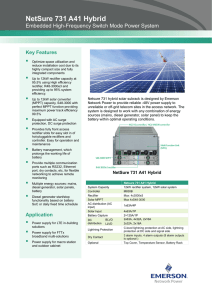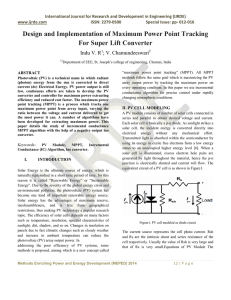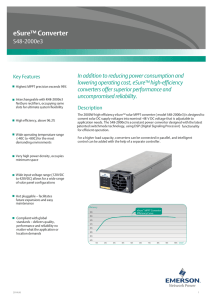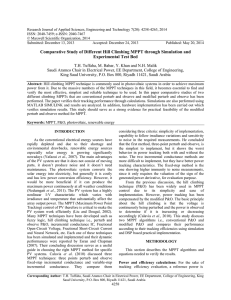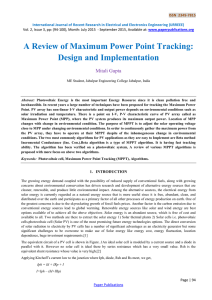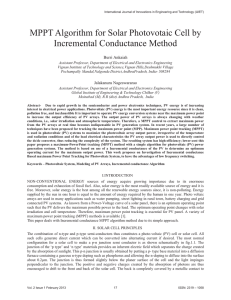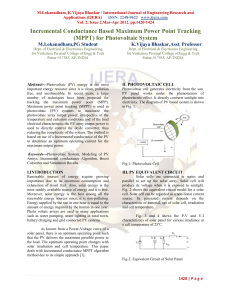Solar PV System with Grid Interconnections and Inc MPPT Control Harinder Singh
advertisement
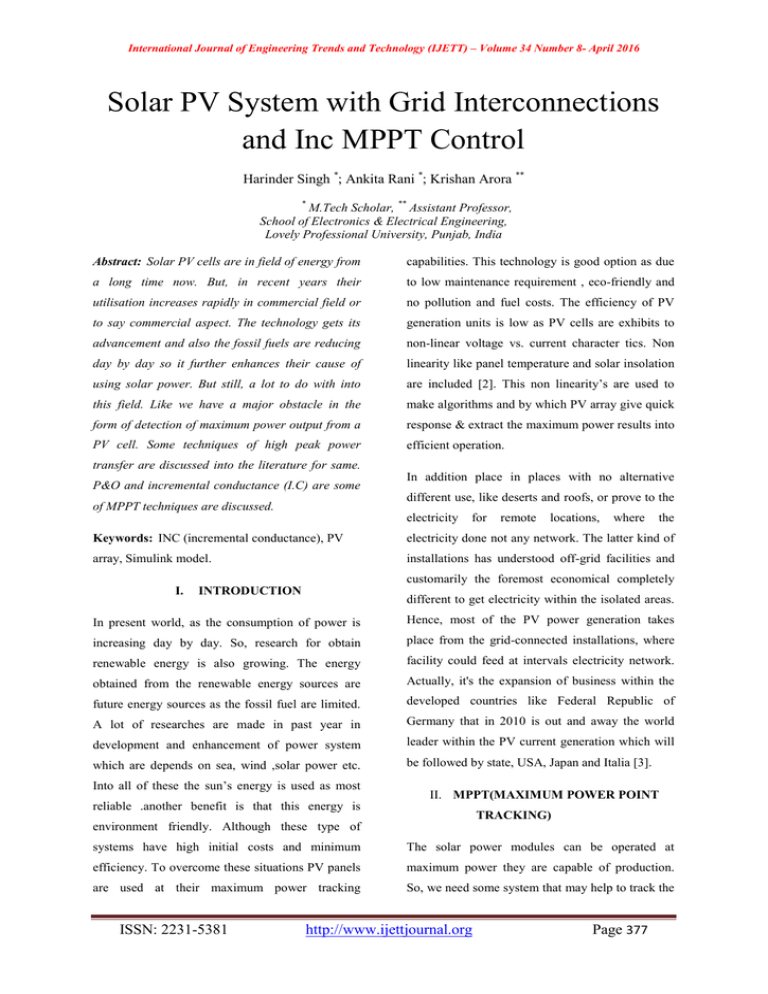
International Journal of Engineering Trends and Technology (IJETT) – Volume 34 Number 8- April 2016 Solar PV System with Grid Interconnections and Inc MPPT Control Harinder Singh *; Ankita Rani *; Krishan Arora ** * M.Tech Scholar, ** Assistant Professor, School of Electronics & Electrical Engineering, Lovely Professional University, Punjab, India Abstract: Solar PV cells are in field of energy from capabilities. This technology is good option as due a long time now. But, in recent years their to low maintenance requirement , eco-friendly and utilisation increases rapidly in commercial field or no pollution and fuel costs. The efficiency of PV to say commercial aspect. The technology gets its generation units is low as PV cells are exhibits to advancement and also the fossil fuels are reducing non-linear voltage vs. current character tics. Non day by day so it further enhances their cause of linearity like panel temperature and solar insolation using solar power. But still, a lot to do with into are included [2]. This non linearity’s are used to this field. Like we have a major obstacle in the make algorithms and by which PV array give quick form of detection of maximum power output from a response & extract the maximum power results into PV cell. Some techniques of high peak power efficient operation. transfer are discussed into the literature for same. P&O and incremental conductance (I.C) are some In addition place in places with no alternative different use, like deserts and roofs, or prove to the of MPPT techniques are discussed. electricity for remote locations, where the Keywords: INC (incremental conductance), PV electricity done not any network. The latter kind of array, Simulink model. installations has understood off-grid facilities and customarily the foremost economical completely I. INTRODUCTION different to get electricity within the isolated areas. In present world, as the consumption of power is Hence, most of the PV power generation takes increasing day by day. So, research for obtain place from the grid-connected installations, where renewable energy is also growing. The energy facility could feed at intervals electricity network. obtained from the renewable energy sources are Actually, it's the expansion of business within the future energy sources as the fossil fuel are limited. developed countries like Federal Republic of A lot of researches are made in past year in Germany that in 2010 is out and away the world development and enhancement of power system leader within the PV current generation which will which are depends on sea, wind ,solar power etc. be followed by state, USA, Japan and Italia [3]. Into all of these the sun’s energy is used as most II. MPPT(MAXIMUM POWER POINT reliable .another benefit is that this energy is TRACKING) environment friendly. Although these type of systems have high initial costs and minimum The solar power modules can be operated at efficiency. To overcome these situations PV panels maximum power they are capable of production. are used at their maximum power tracking So, we need some system that may help to track the ISSN: 2231-5381 http://www.ijettjournal.org Page 377 International Journal of Engineering Trends and Technology (IJETT) – Volume 34 Number 8- April 2016 maximum power of a module. This technique is conversation. This process works as same amount known as MPPT. Main point of this is that it is a of power can be exchange by different level of electronic based system that not physically move current and voltage. Same technique is used to have the module like in mechanical tracker. This will a high current output and battery voltage as a enhance output electrical power of PV module by operating level voltage. Until the controller voltage variation into electrical operating point of system is higher than battery voltage by 5% or more than by this mean a additive power is generated which the output current of array will be higher than increases battery charge current .we also use MPPT input. in addition of some other tracking system .but both may completely different. Solar panels has ability to extract most of power with the help of MPPT. Main principle that is employed is given as this algorithm will change PV array operating voltage to battery level voltage and enhance the output current of system. So, we know that into this technique there is not any movement of the PV array. This technique will lower down the voltage and enhance the current. The output of the array is stabilized by a process called DC to DC Vin Solar Array Vout MPPT Iin Iout Power Supply Figure. 1 : Basic Block Diagram Basic solar cell equations is given by, Where, K Botlzmann’s constatnt, 1.38*10-19 J/K Ki S/C current temp coefficient at Iscr ISSN: 2231-5381 http://www.ijettjournal.org Page 378 International Journal of Engineering Trends and Technology (IJETT) – Volume 34 Number 8- April 2016 Q Electron charge .1.6*10-23 C ƛ Solar irradiation in W/m2 Iscr Short circuit current at 250 Celsius Ilg Light – generated current Ego Band gap for silicon A Ideality factor Tr Reference temperature Ior Cell saturation current at Tr Rsh Shunt resistance Rs Series resistance Figure 2 : Equivelant PV Cell III. INCREMENTAL CONDUCTANCE MPPT high into this method. This may generate oscillations into output power. The comparison of The voltage change is taken into consideration by incremental conductance to array is done if measuring incremental change of array current and outcome is same then error signal is zero and point voltage. This is quite efficient method rather than is MPP. P&O but the requirement of computation is quite ISSN: 2231-5381 http://www.ijettjournal.org Page 379 International Journal of Engineering Trends and Technology (IJETT) – Volume 34 Number 8- April 2016 Figure 3: Incremental conductance The incremental conductance algorithm gives a better tracking efficiency, control over power and very high response by changing automatically to maximum power point by using the previous power point and by comparing the value then the power point will automatically shift to that point thereby sensing intelligently and by the use power electronics now-a-days everything will be done by reducing the losses to a minimal range and very reliable in operation. IV. SIMULATION CIRCUIT Figure 4: Simulation model of MPPT Array using Incremental Conductance ISSN: 2231-5381 http://www.ijettjournal.org Page 380 International Journal of Engineering Trends and Technology (IJETT) – Volume 34 Number 8- April 2016 V. RESULTS AND FINDINGS Figure 5 : Output of boost converter In Figure 5, author has seen the fluctuations due to change into the irradiations into the atmospheric conditions. Response of system can be improved by using some advance MPPT such as the modified neural MPPT algorithm. Figure 6 : Output voltage waveform of inverter From Figure 6, author has observed that voltage reaches to very high value before 0.1 second and decreases after 0.1 second. At 0.5 second the value again increases and then settles down before 0.6 second. After that the voltage is approximately sinusoidal. ISSN: 2231-5381 http://www.ijettjournal.org Page 381 International Journal of Engineering Trends and Technology (IJETT) – Volume 34 Number 8- April 2016 CONCLUSION This work gives approach of using INC technique to solve MPPT problem into PV array that is connected to grid. The output of the PV array is [12] ArashShafiei, AhmadrezaMomeni and Sheldon S. Williamson, “A Novel Photovoltaic Maximum Power Point Tracker for Battery Charging Applications,” IEEE, 2012. [13] Ali F Murtaza, Hadeed Ahmed Sher, et al., “A Novel Hybrid MPPT Technique for Solar PV Applications Using quite better in terms of voltage. Required model for Perturb & Observe and Fractional Open Circuit Voltage adaptive INC algorithm is designed. Further we Techniques”. improve this response by using some advance [14] Weidong Xiao, Nathan Ozog and William G. Dunford, technique with low down THD of given output. “Topology Study of Photovoltaic Interface for Maximum Power Point Tracking,”IEEE Transactions on Industrial Electronics, Vol. 54, No. 3, June 2007. REFERENCES [1] TrishanEsram and Patrick L.Chapman, “Comparison of Photovoltaic Array Maximum Power Point Tracking Techniques,”IEEE Transactions on Energy Conversion, Vol. 22, [15] Jun Pan, Chenghua Wang and Feng Hong, “Research of Photovoltaic Charging System with Maximum Power Point Tracking,” The Ninth International Conference on Electronic Measurement & Instruments ICEMI, 2009. No. 2, June 2007. [2] Hung-I Hsieh, Jen-Hao Hsieh, et al., “A Study of HighFrequency Photovoltaic Pulse Charger for Lead-Acid Battery Guided by PI-INC MPPT”. [3] K.H. Hussein, I. Muta, T. Hoshino and M. Osakada, “Maximum photovoltaic power tracking:an algorithm for rapidly changing atmospheric conditions,”IEEEploc.-Gener. Transmission and Distribution, Vol. 142, No. 1 , Jan. 1955. [4] C.Thulasiyammal and S Sutha, “An Efficient Method of MPPT Tracking System of a Solar Powered Uninterruptible Power Supply Application,” 1st International Conference on Electrical Energy Systems, 2011. [5] NoppadolKhaehintung and PhaophakSirisuk, “Application of Maximum Power Point Tracker with Self-organizing Weight tuning Controller for Solarpowered Traffic Lights,” IEEE, 2007. [6] C. S. Chin, P. Neelakantan, et al., “Weight tuning Based MPPT for Photovoltaic Modules Influenced by Solar Irradiation and Cell Temperature,” UKSim 13th International Conference on Modelling and Simulation, 2011. [7] PanomPetchjatuporn, PhaophakSirisuk, et al., “A Solarpowered Battery Charger with Meta-heuristic approach Maximum Power Point Tracking Implemented on a Low-Cost PIC-microcontroller”. [8] S. Yuvarajan and JulineShoeb, “A Fast and Accurate Maximum Power Point Tracker for PV Systems,” IEEE, 2008. [9] Prof.Dr.IlhamiColak, Dr.ErsanKabalci and Prof.Dr.GungorBal, “Parallel DCAC Conversion System Based on Separate Solar Farms with MPPT Control,” 8th International Conference on Power Electronics - ECCE Asia, The ShillaJeju, Korea, May 30-June 3, 2011. [10] S. G. Tesfahunegn, O. Ulleberg, et al., “A simplified battery charge controller for safety and increased utilization in standalone PV applications,” IEEE, 2011. [11] Yuncong Jiang, Ahmed Hassan, EmadAbdelkarem and Mohamed Orabi, “Load Current Based Analog MPPT Controller for PV Solar Systems,” IEEE, 2012. ISSN: 2231-5381 http://www.ijettjournal.org Page 382

